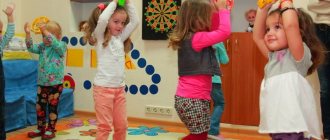Speech development of young children from 1 year to 3 years in kindergarten classes
SEMINAR ON SPEECH DEVELOPMENT OF EARLY CHILDREN
Author: Irina Alekseevna Grebenkova, teacher at the Children's Educational Institution "CRR - Kindergarten No. 110", Syktyvkar, Komi Republic. Description of the material: I offer material on the development of speech in young children (1-3 years). This educational and methodological development will be useful for methodologists, senior teachers for conducting a seminar on this topic, as well as teachers of early age groups for using the information in their work. The material is divided into two parts and contains all the main aspects of speech development in children aged 1 to 3 years. The second part describes the development of children's speech in the classroom. Topic: Classes on speech development, as one of the main forms of working on the speech of young children. Plan: 1. Classes as one of the main forms of children’s speech development. 2. Features of organizing classes with young children. 3. Types of activities for speech development and familiarization with the environment. 4. Features of lesson planning. 5. Methodology for conducting classes on speech development and familiarization with the environment. 1. Classes as one of the main forms of children’s speech development. Classes are one of the forms (effective and economical) of an adult’s educational influence on children, which, in the conditions of public education, should ensure the pace of development characteristic of young children. (G.M. Lyamina) The advantage of classes: - achievement of the task is facilitated by a clear goal, - proven methodology, - the ability to select gradually more complex material. In the 2nd year, speech is one of the leading activities. Its timely development ensures the improvement of other activities. The goal (task) of speech development is set in each lesson. The main line of pedagogy in the 2nd year of life is the development of certain functions and skills in children, in preparation for the future perception of a system of knowledge and skills. If an adult does not teach a child in a lesson how to use story-based and didactic toys, his entire waking life will be spent throwing toys around, staggering from corner to corner, and being capricious. If the teacher does not develop in the process of classes the ability to use words, imitate speech, carry out instructions and rules of the game, it will be difficult to organize his daily behavior, increase his vocabulary, give certain knowledge, teach him to follow the rules of behavior in a team. The main goal of the classes is to develop in children new skills (and partly knowledge), which they cannot achieve in the process of independent practice, in particular in games. This provision determines that the daily number of activities with children of the 2nd year is significantly greater than in subsequent years: 3-4 games and activities daily (2 indoors and 1-2 on a walk), of which one activity is required for speech development and orientation in the environment (as noted by Lyamina G.M.). 2. Features of organizing classes on speech development with young children. Features of organizing classes for children of the second year of life: - Classes are playful in nature. However, they have certain goals, objectives, and means for their implementation and thus differ from games. — From the very beginning of classes, we (educators) set a goal - to instill in children certain rules of behavior: not to disturb others, maintain the correct posture, listen carefully and perceive what is being shown. Children's observance of rules of behavior soon becomes a habit, and the result of an action, movement, or word performed serves as a source of joy. — The education of young children is distinguished by its unique originality: Firstly, they not only have no motives for educational activities, but also lack conscious, voluntary actions necessary for learning, and the assimilation of first knowledge and skills occurs on the basis of involuntary memorization. Secondly, in spite of everything, young children have a high level of learning ability, that is, the learning process begins long before this type of activity becomes the main one in the child’s mental development. — Speech classes are the most difficult for children, they require tension and therefore should be short. When fatigue appears, children are either involved in the activity or finished early. It is important that the kids get complete satisfaction from the lesson. — In order for children to be less distracted during the lesson and it to be more effective, it is advisable to organize it in a different room, not where those who are not engaged are playing. This could be a reception room, a well-lit bedroom. — It is important to provide the most comfortable position for the child during classes, which will help him maintain attention for a long time. Children often play while sitting on the floor, so they do not develop differentiation well, so that during classes they need to behave differently than during play. They jump up, crawl around, grab toys, get distracted. Sitting on the carpet with your legs outstretched is not a comfortable position; children get tired quickly. naturally they try to change it, and at this moment they interfere with another child. If children at the beginning of the 2nd year are seated during class on chairs in a semicircle at some distance from the teacher, they jump out of their seats and run to her as soon as she starts showing a picture or toy. The posture of a child of this age, without support on the table, is often incorrect. It is best to conduct classes at shifted tables, thereby unobtrusively and from the very beginning limiting the child’s desire to get up and grab the toy being shown. — The duration of classes in the 2nd year of life varies from several to 10 minutes, and an indicator that the classes need to be completed is a decrease in activity and distractibility of children. At this age, along with easy fatigue and distractibility, children experience insufficient mobility of nervous processes. It is expressed in long latent periods of speech responses, frequent responses-aftereffects, and a gradual increase in the child’s activity during the lesson. The study showed that in a child at the beginning of the second year, the latent period preceding verbal responses sometimes reaches 20-30 seconds or more. — The number of children in a lesson depends on their age and the material they will work on. Uniting children in small groups during a lesson is possible only if each child is ready to learn (knows how to watch, listen, and act as instructed by an adult). The number of children participating in a lesson depends on the age of the children and the type of lesson, on the degree of mastery of the skill (the less developed a particular skill is, the fewer children participate in the lesson). — The requirements for children must be feasible and not burdensome. Along with new material, it is advisable to use what is already familiar to children. — In classes, the knowledge that is mastered during actions with objects, games, observations while walking, etc. is consolidated. The more meaningful a child’s daily life is, the greater the cognitive opportunities available for activities. — If an adult wants a child to repeat a word after him, his tone should be affectionate, but calm, businesslike, and not overly emotionally upbeat. Only by persistently repeating the instructions can you get the child to focus on the adult’s face, listen and respond. But, of course, there should be no rough training or coercion here under any circumstances. You should cultivate in children the need to speak, constantly create situations in which the child is forced to utter words and phrases: you need to ask an adult for something, convey his instructions in words. The child’s ability to imitate must be developed so much that he can easily repeat a new word after an adult and, as they say, “on the fly” add this word to his active vocabulary. Features of organizing classes with children of the third year of life: During classes on familiarization with the environment and development of speech, cognitive activity develops. The content of classes is determined by the program material, which includes knowledge that the child cannot master on his own. Classes should be predominantly problem-based in nature, which: - firstly, ensures their developmental nature, - secondly, has not only a teaching, but also an educational effect, - thirdly, creates a special interest in acquiring knowledge. As a result, in the third year of life the semantic side of speech, the functions of comparison and generalization, grammatical structure, and articulation intensively develop. 3. Types of activities for speech development and familiarization with the environment. In each program, the “Speech Development” section is presented by different authors, who offer slightly different types of speech development classes, methods and techniques for working on speech development, but in general, the content of the work and the indicators we strive for, the training methods, in principle, are not very different, because all scientists rely on the developments of classics, founders and founders of early childhood pedagogy E.I. Tikheyev, N.M. Aksarin, V.A. Petrov. So, Pavlova L.N. He identifies 4 types of activities for the development of speech and familiarization with the environment at an early age: 1. Observation of real objects and objects of the immediate environment (living and inanimate objects); 2. Staging real and fairy-tale situations using toys; 3. Examination of images of familiar objects in pictures (recognition, naming, narration of the depicted plot); 4. Reading fiction and fairy tales. The activities presented in the above sequence reflect different degrees of abstract thinking (cognition of the surrounding world), which the child gradually begins to master in the second year of life. How is this model of cognition of the environment implemented? acquaintance with reality > reflection of the real world in a toy > flat image of real objects and toys > the word (literature and folklore represent the highest form of abstract reflection and knowledge of the environment). Based on this, it is advisable to use visual teaching aids with young children in the following sequence: - household items, living and inanimate objects, - toys, - pictures, - books. For the development of children of the third year, the same methods and techniques are used as in working with children of the second year of life, namely: - observation of real objects, plants, animals, natural phenomena; - staging using toys; - looking at pictures; - acquaintance with the works of art. literature. When working with children of this age, it is advisable to combine them (use them together in one lesson). This is possible because children are already able to perceive new things with a greater degree of abstraction, based on experience and existing knowledge about the environment. 4. Features of lesson planning. The skill cannot be developed within 1-2 lessons, conducted with a long break, for example a week. Therefore, the peculiarity of their planning is that most of the important classes are repeated in the 2nd year 2-3 times a week, gradually becoming more difficult over the course of a month. The Origins program recommends a total of 10 classes per week: 2 classes per day. Of these, classes on speech development and familiarization with the environment - 3 times a week in groups from 1 year to 2 years and 2 times a week with children aged 2 - 3 years. The program content offered to children in classes on familiarization with the environment and development of speech is reinforced in the process of everyday communication with them. The most important principle of building a system of classes is the gradual complication of their content. It is necessary to keep in mind that the initial and subsequent classes with the same material are held differently: - if the lesson is conducted with familiar material, then already in the first lesson everyone carefully observes the actions of the teacher and listens to him carefully. Such an activity can be carried out without changes only once more (it arouses interest and the children become accomplices of what is happening: they try to imitate the words and actions of the teacher), because with large numbers of repetitions without changes and additions, children lose interest. - if the content of the first lesson was previously unfamiliar to the children, then it can be repeated 3-4 times without changes at short intervals (2-3 days). With each such repetition, the child seems to get used to what is happening and begins to show more interest in it. Complicating the lessons can be done by combining the content of two lessons already well known to the children, focusing on the children’s pronunciation of sound combinations and simple words. New elements can only be introduced into a lesson based on the content of the previous one. There are large individual differences in the development of speech by children: some begin to speak early and pronounce words clearly, others understand speech well, but speak little. Gradually, in the process of individual work with children, these differences are smoothed out. To do this, the teacher must pay attention to each child during the day (talk to him, ask him, ask him to share his impressions). In the 3rd year of life, classes should be challenging for children, overcoming which develops the child’s intellect and will. In addition to familiarizing yourself with the environment, special speech tasks are solved in classes: - expanding the vocabulary of understandable and active speech; — education of sound culture of speech; — improving the grammatical structure of speech; - development of coherent speech (monologue, dialogue) in the process of communicating with children and adults on various occasions, in particular, with the aim of understanding the world around them. When scheduling, you should take into account the number of different types of classes per week, as well as their distribution. The calendar lesson plan for the week is drawn up with increasing complexity of the goal or material. Thus, over the course of a month, classes are complicated twice: the first most difficult lesson is conducted in the first 2 weeks, the second in the third and fourth weeks. The calendar plan provides for the topic and purpose of the lesson, and the material. The same plan should reflect the accounting of classes for the month on a weekly basis. In addition, the teacher notes the children’s attitude to classes, the activity of each child, and concentration in completing the tasks that were proposed. Here the teacher indicates the methodological techniques that he used and which contributed to the effectiveness of the lesson. Techniques for activating the speech of young children (not only in classes): - learning words by imitation from the voice, without showing objects (children have a strong auditory orientation), - instructions, - showing how to operate with objects and toys (learning the names of actions ), - acting out a situation of misunderstanding, - receiving questions (activates mental activity) - especially effective (after 1.5 years), - encouraging speech imitation (activates an auditory orienting reaction), - requests, - repetition, - creating moments of strong interest, - revealing the motivation for action (“We’ll get dressed to go for a walk”), taking your own question and answer (and giving a sample answer: “What does Olya drink? - Milk. Is it tasty milk? - Very tasty! Olya loves milk”) - questions , incl. clarifying, - encourage the initiative to enter into verbal communication, - take all children’s statements seriously, - respond emotionally to the child’s story, - encourage them to express a request in words (for example, addressed to a friend), - give a sample of verbal communication (using words expressing a request , promise, desire to give in to each other). When adapting children to kindergarten for the development of speech and familiarization with the environment, it is advisable to conduct activities that do not require maintaining a fixed posture, for example, group excursions. While introducing the situation, the teacher simultaneously checks their orientation in everyday objects and furnishings. Children learn what it is, where it is, what it is called, which organizes their independent activities outside of class. Gradually, children are taught to study while sitting at shifted tables, which helps them maintain the required working posture. 5. Methodology for conducting classes on speech development and familiarization with the environment. The teaching methodology has its own specifics and is determined by: the psychological characteristics of this age and the characteristics of speech development at this age stage. Children of the second year of life must be taught to distinguish between tasks during classes aimed at developing understanding and active speech and to give their own type of answers to each. Structure of classes with children aged 1-2 years Classes on speech development can consist of three parts. So, the lesson can begin and end with exercises for auditory attention and imitation. The teacher, using different intonations, pronounces familiar words that may be required during the lesson, when reading quatrains, nursery rhymes, encourages children to listen, repeat the sample, the last words of the poem. The main part of the lesson consists of showing objects and pictures. Structure of classes for children aged 2-3 years Children attending kindergarten for the second year already know how to study well. However, their mental processes (memory, attention) are imperfect. Therefore, at this age, an emotional attitude towards the upcoming lesson is important, which increases its effectiveness. The first reminder of the upcoming lesson is a signal for restoring order in the game material. The re -installation is already in the lesson (“We begin to engage in ...”) mobilizing the attention, interest of children, encourages them to accept the work pose and comply with other rules of conduct in the lesson. The lesson cannot be turned into a lesson. Direct training techniques: showing a sample, showing a method of action, explanation - are combined using game. The lesson can sometimes begin with elements of surprise, fairy -tale characters beloved by children can participate in it. Part of the classes takes place in the form of didactic games and dramatization games (staging with toys). Not all classes take place at the tables. The whole occupation can be devoted to the education of the sound culture of speech, but most often exercises to educate the sound culture of speech are carried out as part of a lesson in the development of speech and familiarization with others, occupying 3-4 minutes. Particular attention should be paid to the development of articulation: with sufficient pedagogical work, children of this age quickly master the correct articulation, can pronounce almost all sounds (as a rule, the hissing and sonor sound “P” causes difficulty. Errors in the formation and expansion of the dictionary of children:
- a formal selection of words in the lesson without taking into account the features of their assimilation;
- Most often, the content of vocabulary is nouns, adjectives, at best - verbs. Not enough attention is paid to work on other parts of speech, which makes it difficult to solve the problem of the development of coherent speech; - The tasks of vocabulary work (enrichment, consolidation, activation of the dictionary) are not always specified). It is recommended to make approximate dictionaries (combining words into groups); - lack of interconnection in the work in the classroom and in everyday activities; - little individual work is carried out with children taking into account the level of development of the dictionary; - A formal approach in the selection of methods and methods of vocabulary. This is due to the fact that the essence of the work itself is not taken into account. In the studies of V.I. Zhoginova, 3 directions of vocabulary work in all age groups are distinguished:
1 direction - the expansion of the child’s dictionary based on familiarization with others is based on the ability to perceive, and distinguish objects early in children, on the basis of which the idea of the idea is formed surrounding
These ideas are reflected, fixed in the word. Types of classes: observation, examination of objects and pictures. The general in the methodology of these classes is the organization of the perception of objects and phenomena in general. Receptions should contribute to the concentration of children's attention on the object (an element of surprise, a surprise moment, etc.). The exact allocation of the subject and its naming, repeated repetition: group and individual are required. 2 Direction - the introduction of words denoting the qualities and properties of objects and phenomena - is based on the emerging ability to dissected perception, the allocation of distinctive features of objects and phenomena. In the process of familiarization with the features of objects in children, sensory abilities, mental operations are formed: analysis, synthesis, comparison. The main thing in these classes is the organization of the active activity of children and, above all, the survey actions aimed at isolating qualities, properties when familiarizing themselves with objects. The management of survey actions requires the educator’s exact instructions on what the child needs to do to isolate quality or property and this is fixed in the word. It is important to remember the principle of the relationship of sensory and speech development. The more active the child will act with the subject, the more signs he will isolate, which means he will learn more new words. 3 Direction - the introduction of words denoting elementary concepts based on the distinction and generalization of objects on essential features. In the third year of life, based on the elementary comparison of objects and the allocation of their similarities, the purpose of children are introduced into the dictionary of children (toys, dishes, clothes, transport, fruits, etc. Improving the grammatical structure of speech, the adult encourages nouns in all case forms, in the only and in the plural, and the verbs in the present, past and future tense. When children hear an unfamiliar word, the adult explains its meaning, combining with other familiar words and putting in different grammatical forms. Classes with children with a delay in speech development consists Of the 3 parts. For each part, a new type of activity is required, which, on the one hand, does not cause fatigue in the child, on the other hand it helps him to deal with a long time. It is known that the movements of the hands, namely fingers, stimulates the speech development of the child Therefore, it is recommended to propose a task aimed at improving the movements of the hands in the first part of the lesson. The second part of the lesson is devoted to working with pictures, the content of which should correspond to the level of development of the speech understood by the child. Special tasks should be used to name images of objects and plot pictures for the development of understanding of speech. When conducting classes, a variety of methods should be applied to activate the child’s activities, offering him different tasks: “look”, “take”, “hide”, “find”, “give me”, etc. The third part of the lesson is devoted to the development of any child activities. Games are used to conduct it: lotto, games with paired pictures, a simple designer. The game is held so that the adult and the child should constantly communicate in the course of it. Factors that increase the effectiveness of training:
1. The alternation of various teaching methods (explanations, instructions, shows) with game tasks.
2. A combination of choral answers with individual. 3. The use of various demonstration materials (objects, toys, pictures, figures of the desktop theater, etc.) 4. The use of a wide variety of tasks aimed at giving children the opportunity to change the pose and move. 5. Interest, motivation. Literature: 1. Aksarina N.M. Education of young children. - M.: Medicine, 1977. 2. Lyamina G.M., The development of speech of a young child: a methodological manual. -M.: Iris-Press, 2006. 3. Pavlova L.N. Early childhood: development of speech and thinking: methodological guide. -M.: Mosaic-Synthesis, 2000. 4. Pedagogy of early age: Textbook. aid for students avg. ped. textbook establishments/ G.G. Grigoryeva, G.V. Grub, E.V. Zaprygin, etc.; Ed. G.G. Grigoryeva, N.P. Kochetova, D.V. Sergeeva. - M.: Publishing, 1998. 5. Pechora K.L., Pantyukhina G.V., Golubeva L.G. Children of an early age in preschool institutions. - M.: Humanitarian ed. Center Vlados, 2002. 6. Tikheeva E.I. The development of children's speech (early and preschool age). –– M.: Education, 1981.
We recommend watching:
Speech development of preschoolers Poems for the development of speech of preschoolers Games with sand for children of senior preschool age Summary of a lesson on speech development in the second junior group on the topic: Spring
Similar articles:
Games for speech development for children 6 years old
Games to develop speech for 5 year old children
Development of correct speech in a 3- and 4-year-old child
Theoretical foundations for studying speech development in young children
Stages of speech development at an early age
What should be done to ensure that the child’s speech develops correctly, in time for the baby to grow into a social being?
The development of speech in a child can be divided into several stages:
Period of infant cries (0 months - 2-3 months)
The baby's first cry occurs as a component of a defensive reaction caused by the cessation of placental blood circulation and the cooling of his body in the external atmosphere. A new complex synergy of voice formation is formed before our eyes as a side consequence of the innate synergies of thermoregulation and respiration. It is important that the vocal reaction during the first respiratory factor is not enough for voice formation.
Walking period (2-3 months - 5-6 months)
Observations have shown that the baby reacts to human speech already in the first week of life and stops it by the end of the second. As soon as the baby stops crying, he carefully monitors his mother - her behavior and conversation, imprinting in his memory the leisurely and smooth movements of his hands, head and eyes, the slow pace and volume of her speech.
By 2.5-3 months of life, communication between an adult and him becomes the child’s need, so he again and again uses a set of behavioral reactions that stimulates the adult to communicate emotionally with him.
In the third month of life, the child develops a new skill - he is able to look for an adult and hint at communication. The child fixes a long, concentrated gaze on him and smiles.
In the fourth month of a child’s life, the most significant acquisition is the development of communication between him and an adult using speech sounds.
During the fifth and sixth months, changes also occur in the child’s neuropsychic development. Various speech sounds and movements that are purposeful in nature are added to the child’s proactive appeals to an adult.
During the second half of the baby's life, a business style of communication appears, in which the main role is played by his playing with objects. This communication remains the main one until about 3-4 years of age.
In the period from 6-7 to 9-10 months, the child begins to understand the speech of an adult, which radically changes his usual behavior and affects the development of movements and speech.
At 8-9 months, the baby begins to imitate many sounds unfamiliar to him. The child reacts if he hears his name and can show one of the family members. His reaction to his name is reflexively connected with the sound of words, only in this way can the child learn to understand the meaning of the word.
Period of babbling pseudowords (9-10 months - 12-14 months)
By the end of the first year of life, the baby understands the meaning of more than 10 words and can pronounce at least 5 independently. He is much better at repeating syllables and even words after his parents.
At the tenth month, the child can associate a word he hears with an object familiar to him. Such associations promote speaking, and the baby already perceives simple commands.
Speech development of a child from 1 to 3 years of age.
For the development of understanding of speech at this age stage, it is characteristic that up to 1.5 years of age, connections between objects, actions and their verbal designations develop more intensively. However, the connection between them does not immediately become stable. It is possible that the child may not answer a task correctly understood correctly.
As a child ages, the need for communication arises - he wants to show, tell or ask something. If development occurs normally, then after the first year he develops active speech and the first words appear. True, they can only be understood by a child, depending on which sounds he is able to pronounce and which he cannot.
The period when the child begins to speak
At what age does a child begin to speak? In most cases, this happens by the age of two, even if he manages to utter his first words much earlier.
At the age of 3, the child’s perception of other people’s speech improves. But in some cases, the child hears new words pronounced incorrectly from his peers. Children begin to distinguish between words that are similar in sound and sometimes differ in one sound, focusing not only on a specific situation, but also on the sound design of the word. When learning a new word, a child strives to pronounce it correctly. Children begin to use more complex words with three or more syllables, although they may not always be able to pronounce all sounds correctly.
Speech development in younger preschoolers (4-5 years old)
At the age of 4-5 years, when the child already speaks well and talks with an adult on certain topics, it becomes possible to begin cognitive communication. The child acquires a sufficient vocabulary and begins to form grammatically correct phrases and pronounce sounds normally.
In the fourth year of life, children experience improvements in pronunciation, speech becomes more understandable and distinct. Simple common sentences predominate in children's speech.
In the fifth year of life, the child shows significant progress in mental and speech development. The baby is able to identify and name the characteristics and qualities of objects (for example, size and color), establish the simplest connections and accurately reflect them in speech. His speech becomes more varied, more precise and more meaningful. Resistance to attention and the ability to calmly listen to others to the end increases.
Development of speech in older preschoolers (6-7 years old)
A child of the sixth year of life improves coherent, monologue speech. It can convey the meaning of a fairy tale, poem or a specific situation. When composing a story, he concentrates his attention on the main details, and in most cases misses the secondary ones. In the sixth year, the child’s speech is still improving, phrases become more detailed and accurate, and pronunciation is clearer.
In the seventh year, the child’s speech becomes more and more precise, detailed, and consistent. During the retelling, the child talks not only about the main events, but also touches on everything that he himself read about. He is able to accurately describe a toy or picture, and answer questions posed by the parent after reading fairy tales.
Consultation for parents. Speech development of children 2-3 years old
Lessons should be short, theatrical and rich in games. At first, in order to strictly follow the plan and not be led by the child, it is better to prepare a detailed outline.
Speech therapy rhymes and nursery rhymes during a lesson in the senior group
A variety of speech therapy books, coloring books and other teaching materials provide great help during the classes. There are manuals on the World Wide Web that can be printed and used in home games.
Additional Information. Class notes can be found in the book by O.E. Litvinova “Speech development of young children.” Compiled strictly according to the Federal State Educational Standards program based on the author’s many years of experience, all the exercises in the book are aimed at developing the pronunciation and grammatical structure of the child’s speech.
We teach how to correctly imitate the speech of adults
To correctly imitate oral speech, it is important that the words spoken by an adult sound correctly and clearly. The baby may not immediately say the phrase completely and correctly. The main thing is that even in unclear-sounding pronunciation, the number of syllables is preserved. If out of several syllables of a word a child chooses and pronounces one that is most convenient for him, this is a speech disorder, which at this age already needs to be treated.
How to train the vocal apparatus and develop a child’s speech
The vocal apparatus is formed at an early age on the basis of folk songs and fairy tales. Chastushkas, jokes and other forms of songwriting contain a large number of easily pronounced vowels. Folk songs help increase the number of words spoken in one exhalation, improve the smoothness of exhalation, and also introduce the baby to Russian folklore.
How to get a child to talk: effective methods for developing speech in children 2-3 years old
To get your child to talk you need to:
- Do not give everything at his first pointing gesture, but ask: “Do you want an apple? Or an orange? And only after going through several options, give what you want, thus theatrically stimulating the development of speech.
- Read short poems with your child every day and try to repeat them.
- Arrange some kind of “meetings” of animals in the game and ask: “What does the cow say? And the dog? What about the cat?
Articulatory gymnastics for speech development in young children
Articulation gymnastics is carried out after a preliminary presentation of the exercise to adults. Basic movements:
- Puff out your cheeks;
- Smile;
- Tube (pull lips forward);
- Scapula (wide tongue on the lower lip);
- Punish the naughty tongue (slowly bite the spread tongue with your upper teeth).
Exercises and games that will help develop speech in 2-3 year olds
The following are used as exercises and games for speech development in children 2-3 years old:
- onomatopoeia (animals, vehicles, etc.);
- speech accompaniment of all the child’s actions;
- familiarity with images in pictures and in life. For example, the picture shows a cat. “What does a cat say? Meow” We met a cat while walking. “Remember what the cat says?” etc.









